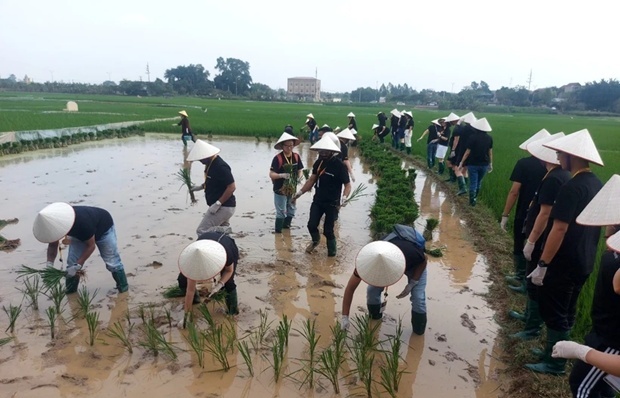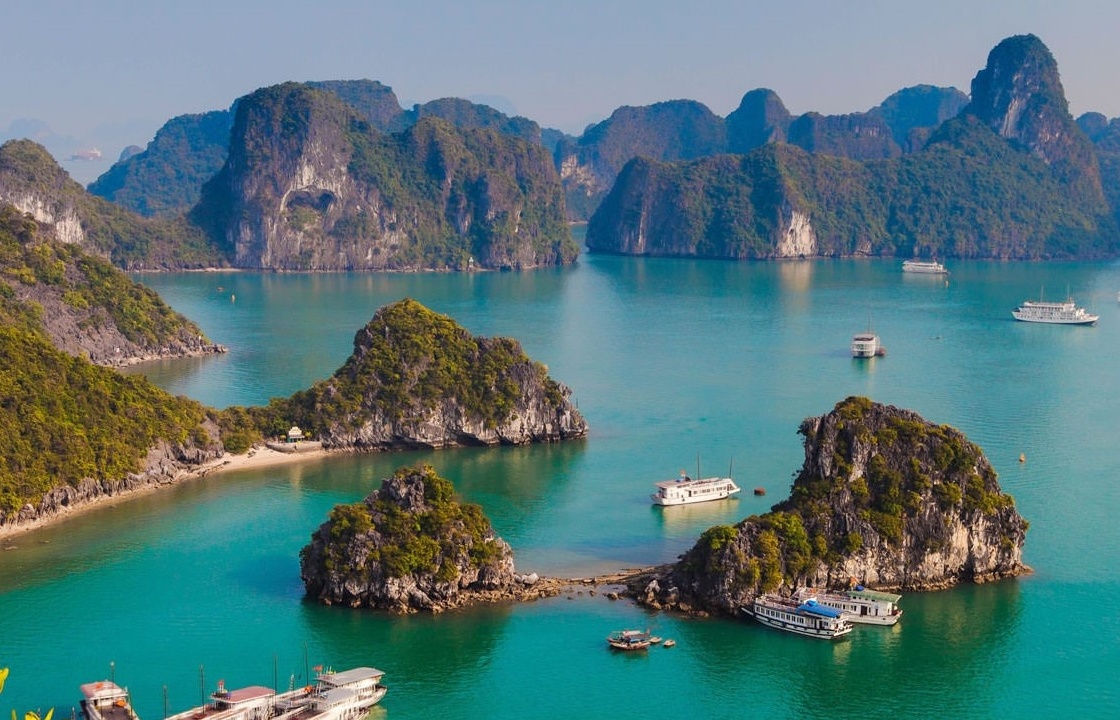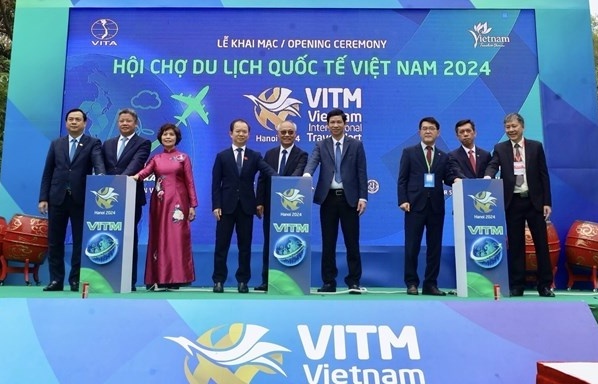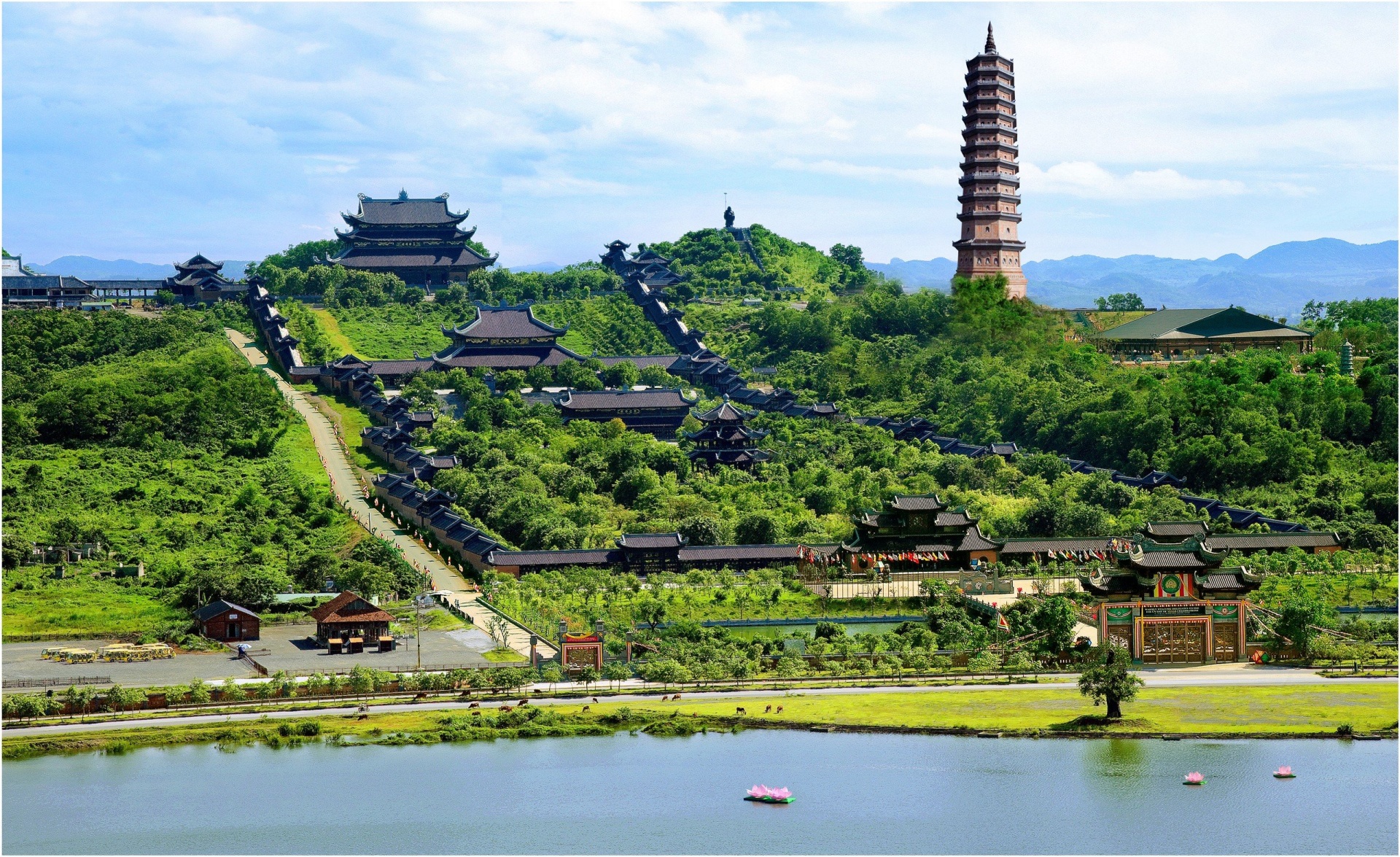Bai Dinh pagoda, between worship and gigantism

Bai Dinh pagoda
Bai Dinh pagoda is a cluster of Buddhist architectural structures, consisting of new, giant and imposing temples of the newly-built Bai Dinh pagoda area which play off ancient and respected shrines of the old Bai Dinh pagoda area.
Bai Dinh Pagoda Mountain is 200m high. It lies between a half – mountain half – plain with an area of nearly 150,000 square metres. A new Bai Dinh pagoda was built next to the old one facing southeast. This pagoda covers an area of 700ha, located on Ba Rau hills, near Hoang Long river. This is a large complex which includes many items built in several different stages. Big, bold and solemn structures, deeply imbued with Vietnamese architecture, Bai Dinh pagoda complex was arranged in five layers upward, including a temple’s inner Three Entrance Gate, a bell tower, a temple dedicated to Bodhisattva Avalokitesvara, Phap Chu temple devoted to the Shakyamuni Buddha, and Tam The Temple dedicated to Buddha.
Three Entrance Gate, which features a three-layer curved roof, covered with glazed dark brown tiles produced in Bat Trang pottery village. Inside, the Three Entrance Gate houses two statues of Lokapalas (Ho Phap), which is 5m high and weights 12 tonnes each, and it is supported by four wooden pillars, which is 13.85m high and 0.85m in diameter each.
Five hundred Arhat statues, made of greenstone, are placed along the two sides of corridors leading up to other structures of the pagoda complex. Each statue, from 2 to 2.5m in height, 2 to 2.5 tonnes in weight, renders unique facial expression and posture that is not expressed by the other.
The Three Entrance Gate is followed by the bell tower, built in the octagonal shape with three-layer curved roof. It houses a bronze bell weighing 36 tonnes.
The temple dedicated to Bodhisattva Avalokitesvara is a seven-compartment single-roofed building where the 90-tonne bronze statue of Bodhisattva Avalokitesvara with many eyes and hands is placed.
The Phap Chu temple devoted to the Shakyamuni Buddha has two-layer curved roof. It is 30m high, 47.6m long, and 43.3m wide. Inside the temple sits the 100-tonne statue of Shakyamuni Buddha. A bronze bell weight 27 tonnes is placed in the temple courtyard.
At the highest location of the new pagoda complex, which is 76m above sea level, Tam The Temple lies. This grave structure is 34m high, 59m long and 40m wide, and has a three-layer curved roof. Inside, the hall is home to three bronze statues of Buddha in the three ages – the past, the presence and the future. Each statue, weighted around 50 tonnes, is 7.2m high.
The ancient Bai Dinh pagoda (Bai Dinh Co Tu) is located on Bai Dinh mountain and at nearly 200m above sea level. Bai Dinh Co Tu lies about 800m from the Tam The temple of the new Bai Dinh pagoda area. The ancient pagoda area is composed of Tien duong (the front hall), the cave where Buddha is worshipped, the temple worshipped the Mountain God, the temple dedicated to Consecrated Nguyen, and the cave where the Mother Goddess of the Forest is worshipped.
According to the Vietnamese concept, the ancient Bai Dinh pagoda is located on an area regarded as a sacred land given it is the birth place of the eminent figures of the nation, including kings, saints and divinities. The pagoda was recognized by the Ministry of Culture and Information (the Ministry of Culture, Sports and Tourism now) as a national historic-cultural relic site in 1997.
Ngoc Well lies nearby the foot of Bai Dinh mountain. As the legend has it, the famous senior Buddhist monk-cum-physician under the Ly Dynasty, Nguyen Minh Khong, used to take water from the well to prepare herbal medicines for the local people and Crown Prince Duong Hoan. The well was built in the moon-shape with a diameter of 30m. The water of the well, which has not run dry once since it was built, is 6m deep.
Apart from the aforementioned structures, others include a place of worship of the Mother Goddess, a place of worship of Ancestors, a tomb stupa, the Vietnam Buddhism Academy, Dam Thi lake, green park, reception area, parking area, etc.
Bai Dinh Pagoda is famous for holding several records. So far, it has had eight records recognized as follows: Biggest gilt Buddha Shakyamuni statue in Asia : the 100-ton statue of Shakyamuni Buddha in Phap Chu temple; Biggest bronze statue of Buddha in Southeast Asia: the 100-ton statue of Maitreya Bodhisattva; Biggest bronze bell in Vietnam: the 36-ton bronze bell in the bell tower; Largest pagoda area in Vietnam: 539ha; Longest corridor with 500 Arhat statues: two wooden corridors with total length of 3,400 m; Largest number of Arhat statues in Vietnam: 500 greenstone Arhat statues; Largest Ngoc (pearl) Well in Vietnam: 30m in diameter, 6m in depth; Largest number of Bodhi trees in Vietnam: 100 Bodhi trees.
What the stars mean:
★ Poor ★ ★ Promising ★★★ Good ★★★★ Very good ★★★★★ Exceptional
Latest News
More News
- Cultivating agricultural tourism model in Hanoi (April 05, 2024 | 14:51)
- HCM City stimulates tourism with discounts up to 60 per cent (April 04, 2024 | 16:01)
- Visitors to Vietnam in first quarter exceeded pre-COVID numbers (April 03, 2024 | 16:42)
- Domestic tourism under threat from high flight costs (April 02, 2024 | 12:19)
- Travelling back to nature (April 02, 2024 | 11:50)
- An Giang launches smart tourism information portal (March 29, 2024 | 10:20)
- Hanoi voted as ‘Best Food Destination for 2024’ by TripAdvisor readers (March 29, 2024 | 10:08)
- AirAsia Cambodia ready to take off starting with three domestic destinations (March 19, 2024 | 18:27)
- Phu Quoc among top beach destinations in Asia (March 19, 2024 | 15:55)
- Favourable visa policy boosts tourism recovery (March 19, 2024 | 15:44)


















 Mobile Version
Mobile Version